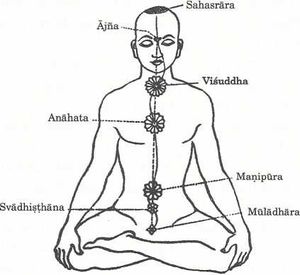Talk:Cakras
<By Swami Harshananda
Cakras literally means ‘circles or centers’.
Origin of The Cakras[edit]
The Śākta Āgamas are more commonly known as the tantras. They declare that the human body is a little universe in itself and various tattvas or cosmic principles in creation are embedded in it. However, each of these tattvas has its own center of activity. This is the place where it is most preponderant and from where its energies radiate into the system. Such centers are called as ‘cakras’ (circles or centers). They have often been linked to lotuses. They are not anatomical centers like the nerve-plexuses but subtle seats of consciousness of Śakti or divine Power.
Principle Nāḍīs[edit]
Works on Yoga depict fourteen principal nāḍīs or subtle conduits for the flow of prāṇic energy. Out of these fourteen nāḍīs three are the most important. All the three start from the root of the spinal column and end near the center of the head. These three nāḍīs are:
- The suṣumnā - It is situated inside the spinal column.
- The Iḍā - It entwines suṣumnā from left.
- The Piṅgalā - It entwines suṣumnā from right.
Cakras in Suṣumnā[edit]
Six cakras are said to be situated in this Suṣumnā. They are:
- Mulādhāra
- Svādhiṣthāna
- Maṇipura
- Anāhata
- Viśuddha
- Ājñā
Mulādhāracakra[edit]
The mulādhāracakra is situated in the space between the anus and the generative organ at the root of the suṣumnānāḍī. It resembles a crimson lotus of four petals. It is the center of the principle of earth called as pṛthvītattva and controls the sense-organ of smell and action organ feet. Brahmā, along with his Śakti Sāvitrī, is the presiding deity of this cakra.
Svādhiṣṭhānacakra[edit]
The svādhiṣṭhānacakra is situated at the root of the genitals. It has it's origin inside the suṣumnā. It resembles a lotus of vermilion color with six petals. It is the center of the principle of water called as aptattva. It controls the sense organs of taste and action organ hands. Viṣṇu along with his Śakti Rākiṇī is the presiding deity of this center.
Maṇipuracakra[edit]
Maṇipura is situated at the navel region. It resembles a lotus of dark hue (like the rain clouds) with ten petals. It is the center of the principle of fire tejastattva. It controls the sense-organ of sight and action organ anus. Rudra with his Śakti Lākinī is the presiding deity of this center.
Anāhatacakra[edit]
Anāhata is situated in the heart region. It resembles a blood-red lotus with twelve petals. It is the center of the principle of air vāyutattva. It controls the sense of touch and the genitals. Īśa with his Śakti Kākinī is the presiding deity of this center.
Viśuddhacakra[edit]
Viśuddhacakra is situated in the base of the throat. It resembles a lotus of sixteen petals of smoky purple color. It is the locus of the principle of ether ākāśatattva. It controls the organ of hearing and speech. Sadaśiva with his Śakini Śakti is the presiding deity of this center.
Ājñācakra[edit]
Ājñācakra is the last cakra of the 'satcakras'. It is situated in the corresponding region to the middle of the eyebrows. It resembles a lotus of two petals of white color. It is the center of the principle of mind. Śambhu with his Śakti Hākinī is the presiding deity of this center.
Sahasrāra Cakra[edit]
The seventh cakra known as the sahasrāra, is the final destination of the Kuṇḍaliniśakti. Kuṇḍaliniśakti is the basic power of the human. It is like a coiled serpent lying dormant at the mulādhāra until it is roused by the appropriate yogic exercises. Beyond this there is the sahasrāra cakra, resembling to a white lotus of a thousand petals. It is presided over by Paramaśiva himself. It hangs from the brahmarandhra (opening at the top of the skull) above the suṣumnā with head downwards.
Saṭcakrabheda[edit]
In fact all these cakras hang with head downwards only, until they are pierced by the Kuṇḍalini. After that it is roused from its slumber by appropriate yogic practices. This piercing of the cakras by the Kuṇḍalinī is called ‘ṣaṭcakrabheda’. When the Kuṇdalinī reaches the sahasrāra and gets united with Paramaśiva, the yogi will go into samādhi, the super-conscious state, experiencing ineffable bliss. The tantras also describe the various results that accrue to a person who contemplates on these cakras in the prescribed manner.
References[edit]
- The Concise Encyclopedia of Hinduism, Swami Harshananda, Ram Krishna Math, Bangalore

